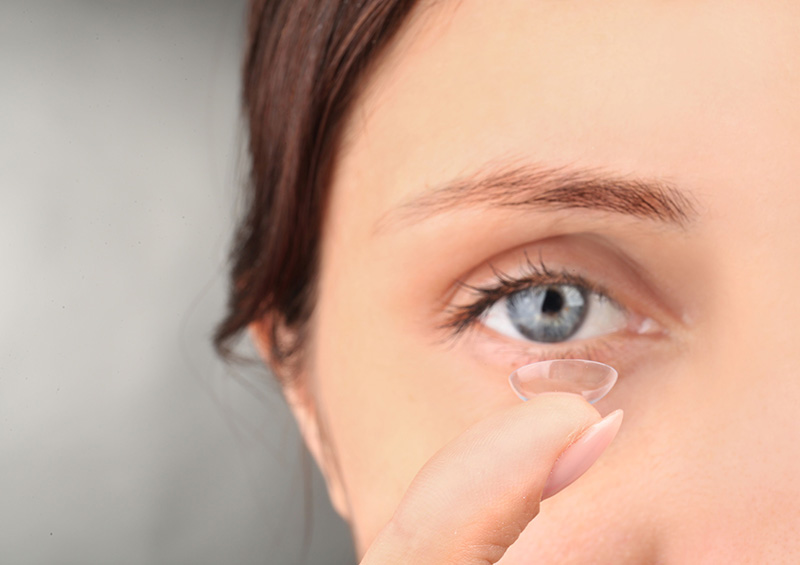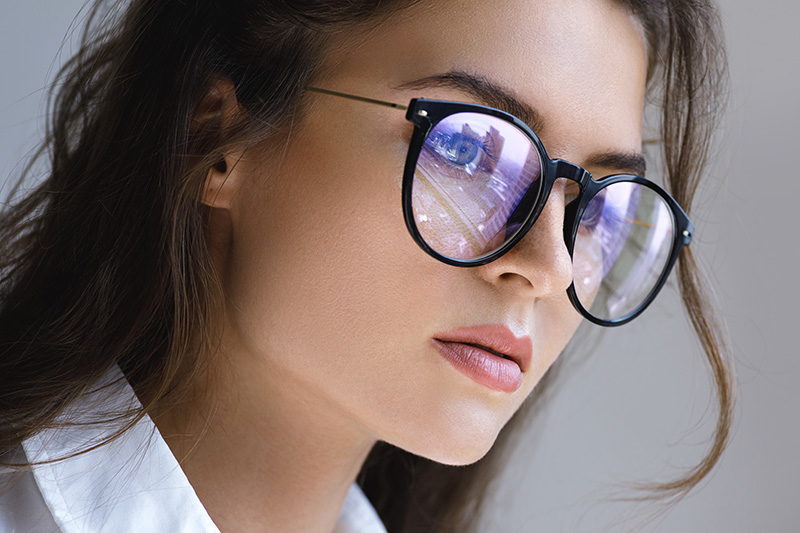Contact Lenses vs. Eyeglasses: A Comparison to See What Meets Your Needs

When dealing with poor vision and the need for correction, you have several options: contact lenses, eyeglasses, and vision correction surgery. Among these, contact lenses offer many benefits due to their unique characteristics, but eyeglasses also have their own advantages. Choosing between them depends on various factors such as your eye condition, lifestyle, budget, convenience, and even appearance.
In this article, we will explore the advantages and disadvantages of both contact lenses and eyeglasses. By comparing their features, you can use this information to make an informed decision that best suits your needs.
Summary
- Pros and Cons of Contact Lenses
- Pros and Cons of Eyeglasses
- Contacts or Glasses? Choose According to the Situation
- Eyeglasses are Essential Even for Contact Lens Users
Pros and Cons of Contact Lenses
Pros of Contact Lenses

- Wide Field of View: Contact lenses fit directly on the eye, providing a wide field of view similar to natural vision. With eyeglasses, your field of vision is about 120 degrees, whereas contact lenses can offer a wider field of view, approximately 180 degrees.
- Less Visual Distortion: Contact lenses can be prescribed differently for each eye, accommodating differences in vision and reducing discomfort, eye strain, or headaches.
- Adaptability to Vision Differences: Contact lenses can be prescribed differently for each eye, accommodating differences in vision and reducing discomfort, eye strain, or headaches.
- True-to-Life Size Vision: With strong myopia or hyperopia, contact lenses do not distort the size of objects as glasses might, so objects appear at their true size.
- Resistant to Movement and Sweat: Contact lenses do not shift during sports or exercise and are unaffected by sweat, ensuring clear vision without interference.
- Comfort: Without the frames of glasses, contact lenses eliminate the discomfort associated with frames, providing a more comfortable experience.
- Aesthetic Appeal: Contact lenses offer a clear and unobstructed appearance, allowing for a clean and natural look without drawing attention to eyewear.
- Change Your Look: Coloured contact lenses allow you to alter your usual appearance and experiment with various styles.
Cons of Contact Lenses
- Maintenance Required: Contact lenses fit directly on the eye, providing a wide field of view similar to natural vision. With eyeglasses, your field of vision is abouExcept for daily disposables, contact lenses require regular cleaning and care.
- Cost: The cost of contact lenses varies depending on the type (daily, bi-weekly, monthly) and lens characteristics, but they tend to be more expensive than glasses. Additionally, non-daily lenses incur extra costs for cleaning solutions and other care products.
- Potential Eye Strain: Incorrect use can lead to discomfort or health issues for the eyes.
- Eye Health Risks: Improper use or neglecting hygiene can increase the risk of eye infections and other complications.
Pros and Cons of Eyeglasses

Pros of Eyeglasses
- Easy to Wear and Remove: Unlike contact lenses, glasses are simple to put on and take off, requiring minimal effort.
- Gentle on the Eyes: Glasses do not place strain on the cornea or conjunctiva, making them gentler on the eyes compared to contact lenses.
- Low Maintenance: The care for glasses is straightforward and generally does not involve awkward procedures.
- Cost-Effective: Although there is an initial cost, glasses can be more cost-effective in the long run due to lower ongoing expenses.
- Wearable in Various Eye Conditions: Glasses can be worn even when your eyes are not in optimal condition, such as when they are dry, irritated, or affected by infections.
Cons of Eyeglasses
- Restricted Field of View: Glasses are positioned about 12mm from the eyes, which can cause peripheral vision distortion and difficulty focusing.
- Discomfort When Wearing: The pressure from the frame can lead to discomfort on the nose and ears. Some glasses may cause this discomfort or pressure after extended wear.
- Inconvenience Due to Environment: During exercise or on hot days, sweat can make the frame slip, which can be bothersome.
- Risk of Damage from Impact: Glasses can break if subjected to external impacts.
- Lens Fogging: Temperature changes or steam from hot food can cause the lenses to fog up.
- Change in Appearance: Glasses can alter the appearance of the face, which might be a concern for some individuals.
Contacts or Glasses? Choose according to the Situation
Each option has its own advantages and disadvantages, making it difficult to choose just one. Some people may also be unsure whether to opt for contact lenses or glasses. In such cases, it might be helpful to consider using both, depending on the environment and specific situations. Let's look at some scenarios!
When Using Sunglasses

In New Zealand, due to environmental factors, ultraviolet (UV) rays are particularly strong compared to other countries, making sunglasses essential when going outside. While prescription sunglasses are available, switching between regular glasses and sunglasses can be inconvenient. In such cases, wearing contact lenses might be a more practical solution.
Some contact lenses come with UV protection, so using UV-blocking contact lenses along with sunglasses can help protect your eyes from intense sunlight. Of course, don't forget to also use sunscreen, a cap, or a hat to further protect yourself from UV rays!
When Playing Sports

As mentioned earlier, wearing eyeglasses while playing sports can be inconvenient due to shifting, adjusting, and potential fogging from sweat. For these reasons, contact lenses are often a more practical choice for sports activities. Many people who usually wear glasses opt for daily disposable contact lenses during sports.
In addition to comfort and convenience, contact lenses provide a wider field of vision and are less likely to be damaged during physical activities, making them a preferred choice for athletes.
However, please avoid wearing contact lenses during water sports.
In water environments, such as swimming pools, bacteria are present everywhere despite pool chemicals, which increases the risk of infections from contact lenses. The water can also contain harmful microorganisms that may adhere to your contact lenses, further increasing the risk of eye infections. Click here to find out more.
When long-term use is challenging
For tasks that require long periods of concentration, such as working on a computer or reading, glasses are more suitable. Contact lenses can sometimes cause dryness or fatigue, so glasses are generally more comfortable for extended use. The recommended wearing time for contact lenses per day depends on the individual’s eye condition, so always consult an ophthalmologist and adhere to the advised wearing time. If you are advised to have a shorter wearing time, it is important to switch to glasses when you return home from work to give your eyes a rest.
Contact lenses and eyeglasses each have their ideal situations. Considering eye health and convenience, it’s a good idea to use them according to specific circumstances. By choosing the right option for different scenarios, you can enhance your overall visual comfort and experience.

Even for those who use contact lenses daily, having a pair of eyeglasses is essential. Here are the main reasons why:
Resting Your Eyes
The eyes need to breathe. Prolonged daily wear of contact lenses can lead to unnoticed oxygen deprivation and put strain on the cornea. To avoid this, make sure not to exceed the recommended wearing time. Consider switching to eyeglasses when you get home or on your days off to give your eyes a break and maintain their health.
When You Can’t Wear Contact Lenses Due to Eye Issues
If you experience conditions such as conjunctivitis or dry eyes, wearing contact lenses could exacerbate these issues. In such cases, it's necessary to switch to eyeglasses. If symptoms persist, consult an ophthalmologist for proper treatment.
In Case of Lost or Damaged Contact Lenses
Despite precautions, contact lenses can be lost, damaged, or run out of stock. In these situations, having a pair of eyeglasses is crucial.
In Emergencies
In emergencies like earthquakes, fires, or hospitalisations, having readily accessible eyeglasses is very practical.

In this article, we discussed the advantages and disadvantages of both contact lenses and eyeglasses. For those who use contact lenses daily, switching to eyeglasses might seem inconvenient, but considering your eye health, it’s important to switch to eyeglasses when necessary.
On the other hand, for those who primarily use eyeglasses, contact lenses might be more convenient in certain situations. Trying out daily disposable lenses can be a good option.
It's important to note that prescriptions for contact lenses and glasses differ. If you have a prescription for glasses, it cannot be used to purchase contact lenses. A separate prescription specifically for contact lenses is required. The primary reason for this distinction is that glasses are approximately 12 millimetres away from your eyes, whereas contact lenses rest directly on the surface. As a result, the correction degree may vary due to the difference in distance. Additionally, contact lens prescriptions need to include measurements for Base Curve (BC) and Diameter (DIA) to ensure a proper fit.
Take care of your eye health and enjoy a comfortable life!
